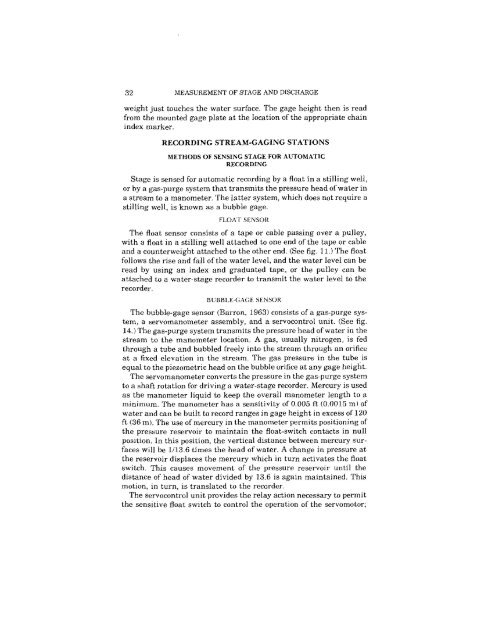PCWA-L 467.pdf - PCWA Middle Fork American River Project ...
PCWA-L 467.pdf - PCWA Middle Fork American River Project ...
PCWA-L 467.pdf - PCWA Middle Fork American River Project ...
You also want an ePaper? Increase the reach of your titles
YUMPU automatically turns print PDFs into web optimized ePapers that Google loves.
32 MEASUREMENT OF STAGE AND DlSCHARGE<br />
weight just touches the water surface. The gage height then is read<br />
from the mounted gage plate at the location of the appropriate chain<br />
index marker.<br />
RECORDING STREAM-GAGING STATIONS<br />
METHODS OF SENSING STAGE FOR AUTOMATIC<br />
RECORDING<br />
Stage is sensed for automatic recording by a float in a stilling well,<br />
or by a gas-purge system that transmits the pressure head ofwater in<br />
a stream to a manometer. The latter system, which does not require a<br />
stilling well, is known as a bubble gage.<br />
FLOAT SENSOR<br />
The float sensor consists of a tape or cable passing over a pulley,<br />
with a float in a stilling well attached to one end of the tape or cable<br />
and a counterweight attached to the other end. (See tig. lU The float<br />
follows the rise and fall ofthe water level, and the water level can be<br />
read by using an index and graduated tape, or the pulley can be<br />
attached to a water-stage recorder to transmit the water level to the<br />
recorder.<br />
BUBBLE-GAGE SENSOR<br />
The bubble-gage sensor (Barron, 1963) consists of a gas-purge system,<br />
a servomanometer assembly, and a servocontrol unit. (See fig.<br />
14.) The gas-purge system transmits the pressure head ofwatcr in the<br />
stream to the manometer location. A gas, usually nitrogen, 15 fed<br />
through a tube and bubbled freely into the stream through an oritice<br />
at a fixed elevation in the stream. The gas pressure in the tube is<br />
equal to the piezometric head on the bubble oritice at any gage height.<br />
The servomanometer converts the pressure in the gas-purge system<br />
to a shaft rotation for driving a water-stage recorder. Mercury is used<br />
as the manometer liquid to keep the overall manometer length to a<br />
minimum. The manometer has a sensitivity of 0.005 ft (0.0015 m) of<br />
water and can be built to record ranges in gage height in excess of 120<br />
ft (36 m). The use of mercury in the manometer permits positioning of<br />
the pressure reservoir to maintain the float-switch contacts in null<br />
position. In this position, the vertical distance between mercury surfaces<br />
will be 1/13.6 times the head of water. A change in pressure at<br />
the reservoir displaces the mercury which in turn activates the float<br />
switch. This causes movement of the pressure reservoir until the<br />
distance of head of water divided by 13.6 is again maintained. This<br />
motion, in turn, is translated to the recorder.<br />
The servocontrol unit provides the relay action necessary to permit<br />
the sensitive float switch to control the operation of the servomotor;
















